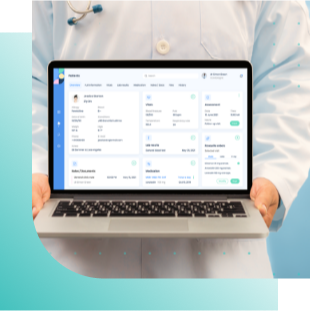Healthcare Analytics
Software Development
From data to better healthcare.
We will build it from scratch for your organization to improve patient
care and optimize operational efficiency.

From data to better healthcare.
We will build it from scratch for your organization to improve patient
care and optimize operational efficiency.



Once we build and implemented with our expertise, the software will collect and analyze clinical and operational information to improve patient care, optimize coordination, and improve outcomes.
With descriptive, diagnostic, predictive, and prescriptive analytics, it helps healthcare providers to deliver better care and make smarter, data-driven decisions.
By developing a customized healthcare analytics solution, your organization can:
Optimize Care:
Use predictive analytics to anticipate patient needs and personalize treatments.
Offer Preventive Care:
Identify high-risk patients early for timely interventions and better care.
Improve Staffing:
Healthcare management uses data analytics to discover, hire, develop, and retain medical workers.
Improve Efficiency: Reduce costs, streamline operations, ensure compliance, provide necessary resources.
Healthcare analytics use large amounts of data to make predictions, gain actionable insights, and advance medical technology.
The healincare analytics software market is predicted to grow from $27.4 billion in 2022 to $85.9 billion in 2027.

213.3



Many patients avoid seeking care due to the hassle of working with the healthcare system. Healthcare analytics software solutions to that problem are the following.

When selecting software for your healthcare business, focus on three
essentials:

Easy integration with your existing systems is critical.
Whether you’re a small clinic or a large hospital, smooth integration is key. The right software will be easy to implement, and staff training will need to follow.
Your software must protect patient data while meeting strict compliance standards like HIPAA and GDPR

Receive personalized treatment plans based on data-driven insights.
Access health plans and records through user-friendly platforms.
Better Outcomes Benefiting from early detection and prevention strategies enabled by predictive analytics.

Efficient Workflows with Automated routine tasks to focus on patient care.
Informed Clinical Decisions by Leveraging comprehensive data analysis for accurate diagnoses.
Collaborate and Share insights across departments for coordinated care.

Identify areas to reduce medical spend without compromising quality care.
Use business intelligence to explore new opportunities in the healthcare market.
Maintain adherence to healthcare regulations with built-in compliance features.

Our structured development process ensures the successful delivery
of your custom healthcare analytics software:
Analysis & Consultation
Understand your organization's needs and
objectives.
Planning and Design
Create detailed project plans and system architectures.
Development
Build the system utilizing agile methodologies for flexibility & efficiency.
Testing and QA
Ensuring functionality, performance, and security.
Deployment
Implement the system within your operational environment with
minimal disruption.
Training
Provide comprehensive training for your staff to maximize system
adoption.
Support and Maintenance
Offer ongoing technical support and regular updates to keep your system optimized.

 JavaScript
JavaScript
 Angular
Angular
 React
React
 Vue.js
Vue.js
 Kendo UI
Kendo UI
 HTML5
HTML5
 Twitter Bootstrap
Twitter Bootstrap
 PHP Laravel
PHP Laravel
 PHP Symfony
PHP Symfony
 Python
Python
 NodeJS
NodeJS
 Microsoft .Net Core
Microsoft .Net Core
 JavaScript
JavaScript
 React
React
 Microsoft SQL Server
Microsoft SQL Server
 PostgreSQL
PostgreSQL
 MongoDB
MongoDB
15 years of working on digital health products in regulated industries.
A wide variety of successful projects and industry expertise.
An innovation culture shaped by mutual trust, creativity, agility and adaptability.
We are honoured to have gained the trust of government and corporate leaders.
We seamlessly integrate to accelerate your teams, delivering world-class solutions on time and within budget.


We develop solutions that are fully secure
and compliant with the globally established healthcare standards and requirements.






We go the extra mile to communicate and understand business objectives, leading to exceptionally high project success.

All vendors claim they can do the job, so that they get it. BGO actually delivers successful projects, and NPS score is the ultimate proof of that.
We work with businesses worldwide, so get in touch!
Start your project’s success here.
We’ll be in touch within one business day.
Enhance patient engagement
Improve operational efficiency
Increase acquisition retention
Enable informed decisions
Streamline patient data
BGO is trusted by top healthcare startups, Fortune 100 companies
and governments for their
digital health solutions.
Healthcare analytics software collects and analyzes clinical and population health data. Its purpose is to help healthcare organizations make data-driven insights, improve patient outcomes, and enhance operational efficiency. It provides actionable insights that enable healthcare professionals to deliver value-based, quality care while reducing costs.
With predictive analytics and advanced healthcare dashboards, healthcare providers can identify high-risk patients, personalize treatment plans, and intervene early to prevent complications. This approach supports strategic growth by driving better outcomes and improving patient engagement.
Absolutely. Security is a key consideration. Our software includes advanced encryption, access controls, and cloud computing solutions to ensure that your data—whether it's lab data, medical spend, or patient records—remains safe and complies with regulations like HIPAA and GDPR.
Yes, our healthcare analytics solutions seamlessly integrate with your existing healthcare ecosystem, including health systems, health plans, and hospitals. We connect multiple sources of clinical and operational data, helping you gain new insights and improve outcomes across your organization.
Custom healthcare software development offers a user-friendly platform tailored to your specific needs, enabling scalability and adaptability for future challenges. It ensures your organization can use the best networks, cutting-edge technology, and life sciences innovations to stay ahead in the healthcare market.
Through business intelligence and actionable insights, our analytics platform helps identify inefficiencies, optimize resource use, and streamline services. By focusing on value-based care and lowering costs, your organization can improve quality care without sacrificing outcomes.
Healthcare analytics accelerates drug discovery by providing detailed analysis of clinical data and population health trends. By identifying patterns, our software solutions enable researchers and physicians to make informed decisions that contribute to the development of effective treatments.
Back to top
Hello!
Did you know that BGO Software is one of the only companies strictly specialising in digital health IT talent and tech leadership?
Our team has over 15 years of experience helping health startups, Fortune 100 enterprises, and governments deliver leading healthcare tech solutions.
If you want to explore your options, would you like to book a free consultation call today?